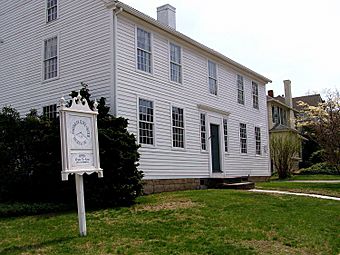Federal Hill Historic District (Bristol, Connecticut) facts for kids
Quick facts for kids |
|
|
Federal Hill Historic District
|
|
 |
|
| Location | Roughly bounded by Summer, Maple, Woodland, Goodwin, and High Sts., Bristol, Connecticut |
|---|---|
| Area | 90 acres (36 ha) |
| Architect | Case, Joel; Et al. |
| Architectural style | Colonial Revival, Mid 19th Century Revival, Late Victorian |
| NRHP reference No. | 86001989 |
| Added to NRHP | August 28, 1986 |
The Federal Hill Historic District is a special neighborhood in Bristol, Connecticut. It's famous for its beautiful old houses built in the 1800s and early 1900s. Imagine walking through streets filled with grand homes! This area grew into a very popular place for people to live, especially those who wanted fancy houses. It was officially recognized as a historic place in 1986.
Discovering Federal Hill's Past
The city of Bristol started way back in the 1720s. At first, it was part of a bigger town called Farmington. But in 1785, Bristol became its own separate town.
Federal Hill is a noticeable rise, or small hill, northeast of Bristol's downtown area. Back in 1744, a church and school were built right at the top of Federal Hill. This spot, now called the Federal Hill Green, was once the very center of Bristol. It's where the first church and school for the town were located!
Over time, new roads and ways of travel changed things. The main activities of the town, like businesses and government offices, moved to other places. However, Federal Hill remained an important spot for churches. Today, there are four churches still standing in the district. It also became a very fashionable place for wealthy businesspeople to build their homes. This trend started in the 1840s and really took off in the last 40 years of the 1800s.
Exploring the Architecture of Federal Hill
The Federal Hill Historic District is a large area filled with history. It's generally bordered on the west by a railroad track that goes around the base of the hill. To the south, it's bordered by High Street. The areas to the east and north were mostly built after the 1920s.
Inside the district, you'll find more than 250 main buildings. These include houses, churches, schools, and a few old shops. There are also many smaller buildings from that time, like garages and carriage houses (which were like garages for horse-drawn carriages).
The most common building styles you'll see are the Italianate style, popular from the 1850s to the 1870s, and the Queen Anne Victorian style. These styles often feature decorative details, towers, and different textures.
One of the most impressive houses in the district is the Beleden House. This grand mansion was built between 1908 and 1910. It was made for a local merchant and banker. The Beleden House is so special that it's also listed on the National Register of Historic Places all by itself because of its amazing architecture.



